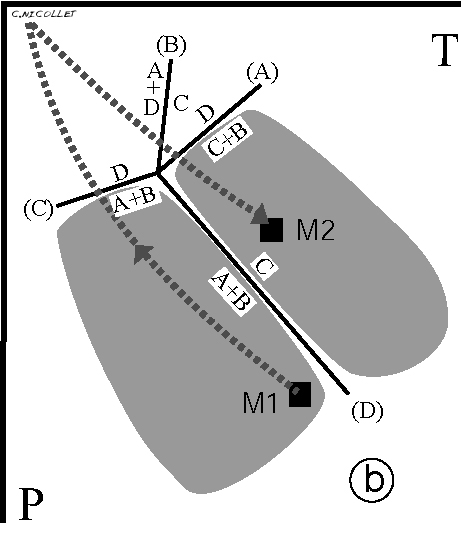On the difficulty of tracing a P-T-time path
To trace the PTt path of a gabbro in the oceanic crust, we have interpreted the coronite texture below as evidence of cooling of the rock in the oceanic crust.We have assumed that the corona develops when the rock passes the equilibrium conditions of the pyroxenes + plagioclase + V = Hbl reaction.

Development of a brown hornblende rim during cooling of a gabbro in the oceanic crust
We interpret this texture by drawing a path that logically intersects the reaction, like the grey arrow in the figure below. However, if we know the conditions P and T of the starting point (M1) and the end point M2, there is not only one possible path (=path PTt) to join these two points in the P-T space. If M1 and M2 correspond to two chronologically separated thermal (metamorphic) events, there is a strong likelihood that the rock formed in M1 will re-equilibrate under geothermal conditions before the M2 event. This is the dashed path below:

a - Two PTt paths produce the cononitic texture of mineral C by crossing the A+B=C reaction. SG is the stable geotherm.
In these two cases, it is assumed that the A+B=C reaction, at the origin of the coronite texture, has been crossed: the rock has moved from the stability field of the A+B assemblage to the stability field of the C+A/B assemblages.
However, during the cooling and exhumation following event M1, the A+B assemblage may have been preserved in the rock in a metastable state at low pressures and temperatures, outside the stability range of the A+B assemblage.

b - In this case, the PTt pathway producing the cononitic texture of mineral C does not cross the A+B=C reaction.
Indeed, for kinetic considerations, the reaction A+B=D may not take place: this explains the presence of metamorphic rocks on the surface of the globe. During the M2 event, the metastable assemblage A+B is moved into the stability field of the A-C and B-C assemblages: the coronite A-B-C assembly is formed, but without the A+B=C reaction ever being crossed.
This means that a reaction can be achieved without having been crossed in the P-T space. To understand this surprising fact, it should be remembered that we are considering P-T diagrams in equilibrium to explain coronitic assemblages in disequilibrium. Thus, along the grey path (solid line) of the figure a, the reaction is not achieved "on" the reaction (i.e. for the PT conditions of the reaction), but when this is overtaken. And the greater the gap of T and P from the P-T conditions of the reaction (the overstep), the greater the reaction rate. An ice cube taken from the refrigerator and left at 0°C will not melt. However, it will melt faster at 30°C than at 5°C!
Let's go back to the phase rule: on the univariant reaction line, the three minerals A-B-C are in equilibrium. If the rock containing A-B reaches the reaction conditions, these 2 minerals are still in equilibrium and do not react. It is only after an overstep of T and P that the reaction takes place. Thus, in the previous figures (a and b), the reaction A+B=C will take place at point M2, regardless of the path taken to reach this point and, in particularly, a path that may never cross the line of the reaction (figure b)!
Therefore, can we state that the amphibole corona in the microphotograph above was formed during a cooling path through the reaction pyroxenes + plagioclase + V = Hbl (point 2 of the path of the Gabbro in the oceanic crust), testifying to the cooling of the oceanic lithosphere? In this case, petrographic analysis is not sufficient to reach a definitive conclusion! In some cases, however, the colour of the amphibole corona varies from brown to green at the rim. The chemical composition of the amphibole reveals a decrease in titanium content (responsible for the brown colour) towards the green rim. The Ti content of the amphibole is temperature dependent and its decay is consistent with corona growth during cooling.
The PTt path of the figure b is not a view of the mind, but is probably common in the case of polycyclic events. The detailed study of metanorites (a norite is an orthopyroxene - plagioclase gabbro) of the french Massif Centralprovides a good example: These rocks, emplaced in the ante-Hercynian oceanic crust around 490Ma, were metamorphosed around 410Ma during a prograde metamorphism and developed beautiful, apparently retrograde coronites. (see this work and the paper ?)
 Back to the PhotoGallery or to the Home Page ?
Back to the PhotoGallery or to the Home Page ?


